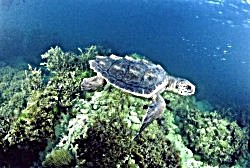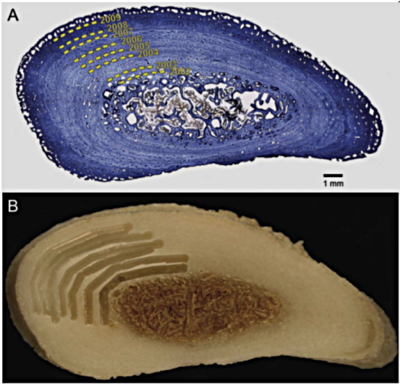RAMIREZ’S WORK ON SEA TURTLE ECOLOGY PUBLISHED IN ECOSPHERE

Matthew Ramirez, a NOAA LMRCSC supported doctoral student in fisheries science at Oregon State University, recently published an article in Ecosphere, titled, “Patterns of loggerhead turtle ontogenetic shifts revealed through isotopic analysis of annual skeletal growth increments.” The article is co-authored by Larisa Avens, Jeffrey A. Seminoff, Lisa R. Goshe and Selina S. Heppell.
Ramirez earned his Master of Science from the Department of Fisheries and Wildlife at Oregon State University in December 2014 and began working on his Ph.D. in the same department in January 2015.
Ramirez’s research interests include sea turtle ecology and population dynamics. Under the direction of Heppell, Ramirez is currently developing laboratory and quantitative methods to better understand Kemp’s ridley sea turtle habitat associations, diet specializations and population dynamics in the Gulf of Mexico and Atlantic. His research analyzes sea turtle humerus bones to gain information on life history variation, which can then be used to inform population models and ultimately help guide effective conservation and management of sea turtles.
“Sea turtles and many other marine species are difficult to study because they spend the majority of their lifetime off shore,” Ramirez explained. “This research focuses on developing a new method to study their bones to infer what they were doing during these cryptic periods, where they are going and what they are eating, which is otherwise very difficult and expensive to do.”
Ramirez says this work aligns with the mission of NOAA because it includes species that are endangered and/or threatened and it can elucidate spatial distribution of the species, or how long they may spend in different parts of the ocean. This information could help improve assessment models and management of the species.
Ramirez was part of a project funded by the LMRCSC for the 2012 and 2013 academic years titled, “Analysis of variability in foraging ecology and juvenile growth to improve an assessment model for loggerhead sea turtles.” Findings from the research project were applied to the article in Ecosphere and became part of his master’s thesis.
“I’ve had a great experience with the LMRCSC,” Ramirez said. “I wouldn’t have been able to do the research to the extent that I did without LMRCSC support.”
Following his Ph.D., Ramirez hopes to work for NOAA and apply his experience with the research model he has demonstrated in his master’s and doctoral level research.
To learn more about Ramirez and his research, visit his website at http://mdramirez.com/.

From Ramirez et al. (2015): Fig. 2. (A) Histologically processed and (B) micro-milled humerus bone cross-sections from a juvenile loggerhead sea turtle that stranded dead on 7 December 2009, with a measured straightline carapace length (SCL) of 51.2 cm and an estimated age of 11.25 yr. Dashed lines delimit the outer edge of each skeletal growth increment, or line of arrested growth (LAG). The calendar year associated with each LAG is provided.
Citation and Abstract
Citation: Ramirez, M. D., L. Avens, J. A. Seminoff, L. R. Goshe, and S. S. Heppell. 2015. Patterns of loggerhead turtle ontogenetic shifts revealed through isotopic analysis of annual skeletal growth increments. Ecosphere 6(11):244.http://dx.doi.org/10.1890/ES15-00255.1
Abstract: Ontogenetic changes in resource use often delimit transitions between life stages. Ecological and individual factors can cause variation in the timing and consistency of these transitions, ultimately affecting community and population dynamics through changes in growth and survival. Therefore, it is important to document and understand behavioral and life history polymorphisms, and the processes that drive intraspecific variation in them. To evaluate juvenile loggerhead sea turtle (Caretta caretta) life history variation and to detect shifts in habitat and diet that occur during an oceanic-to-neritic ontogenetic shift, we sequentially analyzed the stable isotope composition of humerus bone growth increments from turtles that stranded dead on Southeastern U.S. beaches between 1997 and 2013 (n = 84). In one-half of the sampled turtles, growth increment-specific nitrogen stable isotope (δ15N) data showed significant increases in δ15N values over each turtle’s life. These data were used to provide a new line of evidence that juvenile Northwest Atlantic loggerheads exhibit two major ontogenetic shift patterns: discrete shifts (n = 24), which were completed within one year, and facultative shifts (n = 14), which were completed over multiple years (up to five). The mean difference in pre- and post-ontogenetic shift δ15N values was 4.3‰. Differences in isotopic baselines between neritic and oceanic habitats of the Northwest Atlantic Ocean make it likely these patterns are driven by a coupled change in both habitat and diet, and that facultative shifters utilize both neritic and oceanic resources within transitional growth years. Mean size and age at transition between habitats (54.2 cm straightline carapace length, SCL; 11.98 yr) was within the range of previous estimates and did not differ between discrete and facultative shifters. Our results further expand our understanding of loggerhead sea turtle life history polymorphisms and demonstrate the value of bone tissue analysis to the study of this variation. Sequential analysis of annual skeletal growth increments provides a valuable method for reconstructing long-term ontogenetic changes in foraging ecology and habitat use in long-lived, cryptic marine species.
PHOTO CREDIT:
Top, right: Photo by Marco Giuliano and courtesy of NOAA
Bottom, left: Photo by Matthew Ramirez

